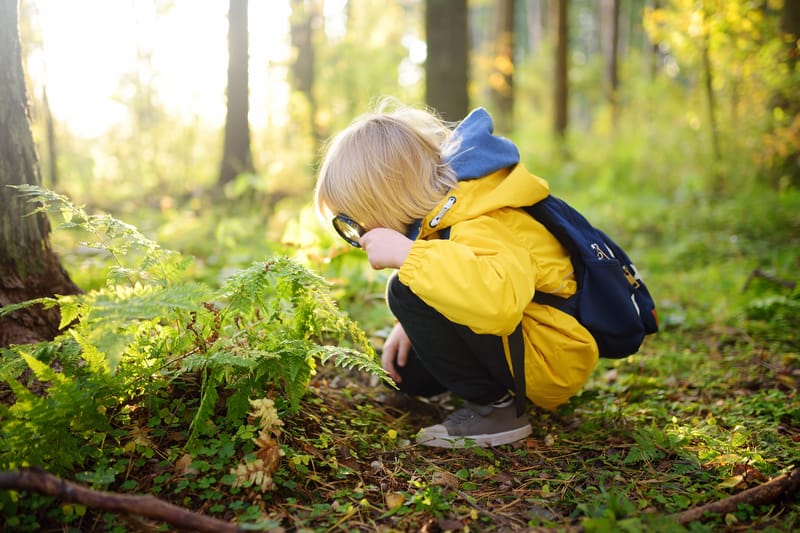Forest School FAQ

What is Forest and Nature School?
Put simply (as simple is often best!), Forest and Nature School is a pedagogy that is learner-centered, child-led, process-oriented, emergent, inquiry-driven, play-based and place-based.
Learning happens in meaningful relationship with the same piece of land. Relationship to Land is a huge part of Forest and Nature School, and there are other Relationships that are of great importance too. As described by Adrian Alphonso and Lise Brown of Momenta and adopted by CNAC (the Child and Nature Alliance of Canada), the 7 relationships of Forest School are:
Relationship with Play
FNS is play-based - it holds that play is synonymous with learning. Play is the way that children learn, the way they develop, challenge themselves, and be creative. It is how they process feelings and develop strategies; it can be interpersonal, physical, creative, and so much more. FNS creates lots of time and space for children to dive deeply into their play. Facilitators safeguard play, and are defenders of wonder.
Relationship with Learning
Forest and Nature School helps strengthen participants' relationship with learning itself, helping cultivate a lifelong love of the process of learning and ensuring that information is integrated holistically. Learning is emergent: arising from experiences, from things encountered in nature, from the desire to use tools, to build things, to move, from creative ideas, and more - and inquiry driven: learners are given space to ask questions, to wonder, to ponder and think, rather than just regurgitate information - and facilitators may respond by sharing information and reflections, books, information and materials for learning, and in turn ask the children questions to help their process of understanding.
Relationship with Power
In Forest and Nature School, power is shared. Rather than adults telling children what to do, there is a process of agreement on which direction the play and learning will take on a given day, or in a given moment. The power of the Land is respected, the power of the learners is respected, and the power of facilitators is respected. There is a balance of power ensuring that safety, respect and considerateness are being learned, whilst true freedom of play can happen within that container of respect.
To be continued... (descriptions to come:)
Relationship with Trust
Relationship with Land
Relationship with Story
Relationship with Risk
Although the methodologies of FNS may seem simplistic, they are actually very sophisticated and rooted in a deep understanding of human nature, and supported by ongoing studies and research by child development specialists (see 'Benefits of Forest and Nature School' for more details on studies done).
What kind of education credentials do your staff have?
Our program directors and main facilitators are either certified, or well into their path to certification by the Child & Nature Alliance of Canada (CNAC) as Forest and Nature School Practitioners, and demonstrate an excellent understanding of the ethos and principles of Forest School. They have a great deal of experience facilitating learner-centered, play-based and place-based learning.
In hiring additional staff, we will determine eligibility for the role of facilitator on a case-by-case basis, with preference given to those who are deeply familiar with the ethos, have dedicated training in Forest School, or have other similar credentials and experience.
All staff will be trained in Standard First Aid and CPR, and have clear Child Abuse Registry and Criminal Record Checks.
Are you insured?
Before our FNS programming commences, our program will be fully insured with general liability insurance. Our Policies and Procedures document for safety and responsible conduct is complete, extensive and thorough.
What is the history of Forest and Nature School?
Forest and Nature School began in Northern Europe (Denmark) in the early 1950's, begun by a Mom running a daycare who wanted to get the kids outside - the first one was called 'Walking Kindergarten'. By the late 1950's it had blossomed into a veritable movement across Scandinavia, and quickly spread to the rest of Europe, Australia, Aotearoa (New Zealand), China and the United States.
It has been gaining steam in Canada with huge popularity on the West Coast and in Ontario especially. Manitoba is picking it up as well.
We acknowledge that Forest and Nature School pedagogy actually goes back further than the 1950's, and elements of it have been in the educational systems of Indigenous people here on this land for a very long time as well. Horizontal/non-hierarchical, learner-centered, emergent and inquiry-driven learning, as well as land-based, place-based, contextual learning that embraces the teachings in risky play and the nuances of the realities of living in the natural world has always been a part of the many diverse education systems of Turtle Island.